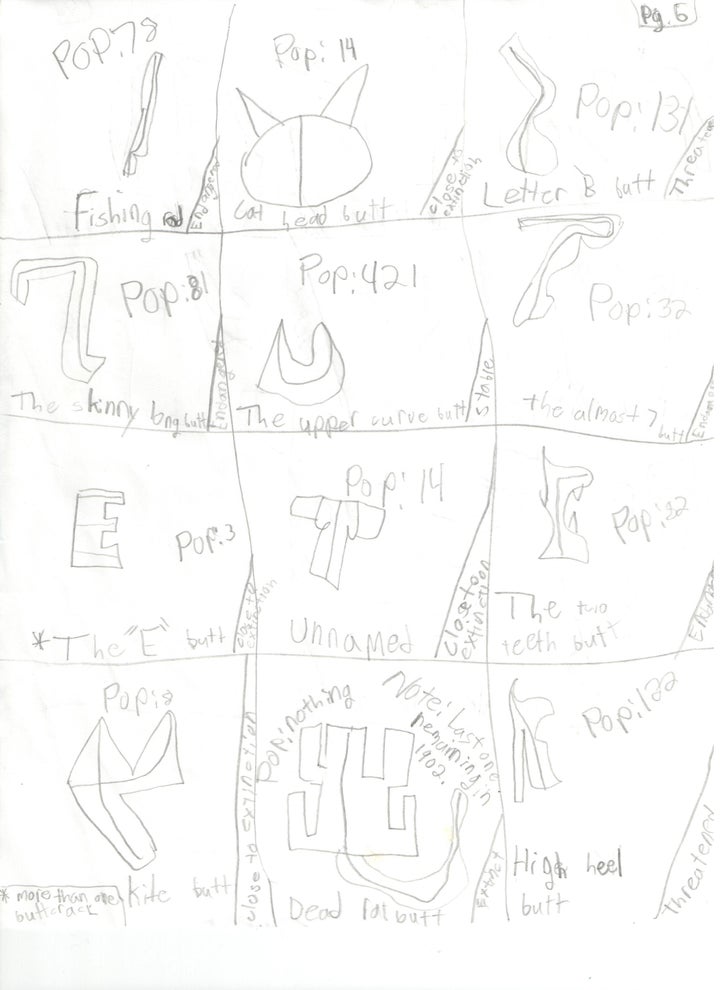
Written by Valerie Weaver-Zercher for Babble.com
My 9-year-old comes from a long line of birdwatchers. His grandparents are avid birders, with almost 900 species on their lifelong lists, and his father and I enjoy watching birds in our backyard. My son frequently pores over our Sibley Guide to Birds and has recently started a list of all the birds he's seen.
So maybe we shouldn't be surprised by his new hobby. Combine the classification skills of a birder with the scatological sensibilities of a 9-year-old, and what do you get? Butt-watching. With the help of his brothers, our middle son is writing and illustrating a book titled Look of Butts, with sketches of bottoms all labeled with the care of little Adam naming the creatures. His taxonomy of tushes features species like the "Pac-Man Crack-Man," the "Doggone-It Wiggler," and my favorite, the "Origanal." There's even one butt inspired by birdwatching: the "Binocs."
The drawings are stylistic and abstract, with baroque lines and improbable angles. In fact, the illustrator seemed less interested in realistic representation of actual rears than in a kind of platonic ideal, an essence of "butt-ness." The result is a cross between a Pocket Guide to the Gluteus Maximus and an artist's sketchbook of the derrière. He also has a population chart that maps the frequency with which each butt species appears, ranging from common butts (the Warthog Nose, for example, of which there are 1,251), all the way down to threatened, endangered and extinct (the Robot Butt, sadly, was last seen in 1781).
Some parents would not encourage their children in such pursuits. And when we first found Look of Butts pages scattered across the basement floor, my husband and I did consider nipping this cheeky project in the bud. We were grateful that he apparently confined his butt-drawing to our home, but still: aren't kids supposed to draw rainbow-colored fish, steep-roofed houses and mommies and daddies floating, Chagall-like, through the sky? Drawing 40-some breeds of butt seemed a little odd, if not deviant. Creative, but deviant.
But since my husband and I have tried to raise our kids to love the natural world, we know we are partly to blame for the work of our Roger Tory Peterson of the Posterior. For what could be more natural than these cushions of fat on which we so deeply depend for various reasons? Buttocks allow us to sit upright; without them, we'd have to collapse to the ground as horses do, our arms planted there like the legs of a tripod. And while most of us prefer not to mull over the role of our rumps, they are essential to any act of sitting, standing, voiding or coupling.
Yes, buttocks have been sexualized, sculpted, ogled and obsessed over. But I think his field guide to fannies has less in common with salacious commentary on Kim Kardashian's keister than with the enduring potty humor of a grade-school boy. In fact, I'm hoping that my son's interest in bums will turn into a willingness to confront the nasty realities of life. For while the signature function of the butt -- the expelling of excrement -- is nearly as critical as breathing, most people find it repulsive. Our friend Jeremy, who leads outdoor adventure trips, says that dealing with one's waste in the wilderness is a metaphor for learning to handle other undesirable matters: those aspects of our personalities and histories that we'd rather flush away.
So perhaps we should celebrate the "Poop-Gun," the "Curvy-Scurvy" and their sister gluteal species. Perhaps training his lenses on the humble heinie will help our son when life moons him, as it inevitably does to us all. Perhaps he will know that encountering the backside of reality is natural, and that you must look carefully at things -- even gross, stinky things -- to learn their contours and to give them a name. Then you must take a pencil and write it all down.
LOOK:

MORE ON BABBLE